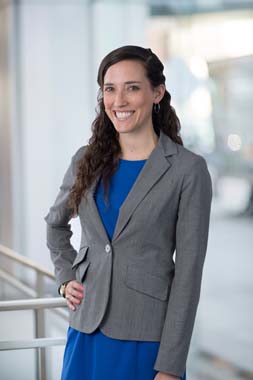2019 Rising Star: Renee Fiala, AIA, medical planner, EYP (Houston)
After completing a master’s degree in architecture from Texas A&M University in 2014, Renee Fiala joined EYP’s Houston office as the firm’s Tradewell Fellow, a prestigious career-building program that provides aspiring healthcare architects with an opportunity to work closely with senior medical planners and designers to gain experience. Following the fellowship, she joined EYP full-time as a medical planner and is now responsible for creating optimal healing environments through collaborative design methods.
Healthcare Design: What drew you to a career in healthcare design?
Fiala: When I was young, I was admitted to a local facility’s emergency department after a minor biking accident. Unfortunately, to this day, what I remember most about that trip is that it was a very long and drawn-out experience that made a huge impression on me. Later, when I was provided with an opportunity to explore a healthcare design studio during college, I reflected on that time and realized I could leverage my firsthand knowledge to better design facilities to improve the experience of future patients and their families. It was the right choice. During the studio, I quickly realized how rewarding the profession could be, as it became clearer that the people in a healthcare facility can significantly benefit from innovative, impactful design.
What’s one recent project that you’re most proud of?
I was part of the EYP team that created a medical-surgical suite dedicated to elective surgeries for Hackensack Meridian Health, Ocean Medical Center in Brick, N.J. As part of this project, we modified the original schematic design of a shell floor to better address the needs of the newly designated patient population. My role on the project was focused on working with our researcher to better understand the underlying causes of patient falls. We developed solutions to improve patient safety, focusing on improving visibility into patient rooms, establishing open nurses’ stations for improved observation, and providing accessible bathrooms for all patient rooms. Through this, I learned the importance of working closely with staff, patients, and visitors to solicit feedback and ensure that the facility’s design is strategically developed to better meet their needs.
What do you think is the number one issue facing the healthcare design industry in 2019?
It’s well-known that healthcare is trending toward a model that’s more consumer focused as a result of shifting patient preferences, the ever-increasing consumerization of medical IT, and more. This trend should be directly reflected in the design of healthcare facilities, of course, but that’s not usually the case. Personally, I believe that this is due to a lack of accountability. Facility designs should be studied more thoroughly once occupied and on a continuous basis.
What’s one idea you have for overcoming that problem?
The best way to ensure that studies on designs and their efficacy occur and results are distributed more broadly is for clients to demand that of the firms they work with. As a rule of thumb, this is one of most efficient ways of pushing design firms to innovate, whether that be in regard to design, research and development, or something else entirely. I believe this effort will stem from an improved awareness of design innovation’s impact on operational efficiencies and on patient-reported outcomes; an increase in the amount of available and reputable third-party data would expedite this process, as it would bring the importance of design to clients’ attention. Following this, I find it difficult to envision clients refraining from investing heavily in superior and/or innovative design. Additionally, I think this shift would encourage clients to be more cognizant of design’s financial implications when evaluating cost-saving opportunities. Data sourced from facilities’ designs and their impact on operational efficiencies and patient-reported outcomes could very well change the industry’s entire perspective on return on investment.












